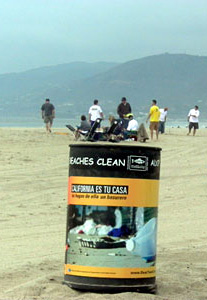 |
 |
 |
 Editorials | Environmental | August 2006 Editorials | Environmental | August 2006  
Dirty Beaches a Health Hazard, Says Report
 Elisabeth Leamy - ABC News Elisabeth Leamy - ABC News


| | Six beaches in Orange County, Calif., made the NRDC's list of the 22 dirtiest beaches. |
From sea to shining sea, beaches across the country are facing a rising tide of dangerous pollution.

In Port Angeles, Wash., toilet paper floated in the harbor and 30 miles of beach closed after the city's main sewer pipe broke.

A worker testing the water said, "This is raw sewage - it has the usual fecal coliform and bacterias and things like that."

At Rocky Point Beach near Baltimore, rain and floods in June flushed raw sewage into the Chesapeake Bay.

Some beachgoers found that out after they were already in the water.

"I was in there a little while then the lifeguard ordered us to get out of the water," Kinnary Vyas said.

And just this week, cooling down in Lake Erie near Cleveland could have been hazardous to people's health - bacteria levels at Edgewater Beach exceeded state standards. Yet some people ignored the warnings and still went into the water.

Environmental Group Sues EPA

The Natural Resources Defense Council's eye-opening annual report on the state of the nation's beaches is due out later today.

It will show contamination caused health warnings and beach closings at least 20,000 times in 2005, more than ever before.

"What that means is for those beaches on those days there were dangerously high levels of bacteria," said the NRDC's Nancy Stoner.

The increase could be due to better testing. The Environmental Protection Agency says four times as many beaches are monitored today as were a decade ago.

Still, the NRDC plans to sue the EPA, alleging it has failed to improve monitoring standards as required by law.

"It takes 24 to 48 hours to get results from the monitoring tests," Stoner said. "That means that people are swimming in human and animal waste without being warned of the danger."

Six beaches in Orange County, Calif., made the NRDC's list of the 22 dirtiest beaches.

But the county says areas where people swim at those beaches routinely meet standards - at least in the summer when most people are in the water.

And it says some of those so-called dirty beaches are among its cleanest.

The report also says that the EPA is doing very little to find the source of the contamination.

The EPA says it is working to develop techniques for testing beach water faster, but for now, beaches remain open to swimmers while water samples are processed.

What should you do?

• Obey warning signs - we've heard from all over the country that people ignore them and swim anyway.

• Avoid swimming the day after a heavy rain because the stormwater runoff usually contains a lot of pollution.

• Stay out of the water if you have open cuts or a weak immune system, or at least keep your head above water to avoid ingesting it.

• Cook fish and shellfish thoroughly to kill bacteria.

• Dispose of trash properly. | 
 | |
 |



